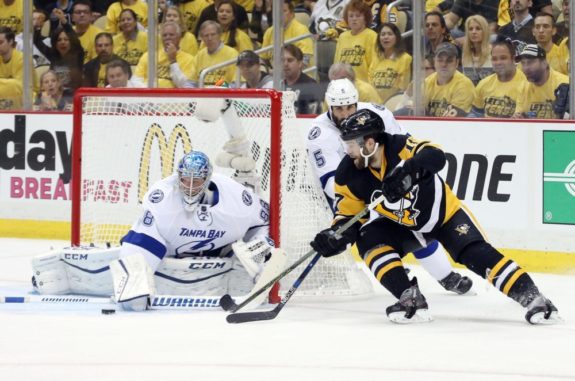
 Dan J Kirk
The Hockey Writers
Dan J Kirk
The Hockey Writers
25
Reads
0
Comments
Penguins Should Really be Better in Overtime
One might think that the three-on-three overtime format would benefit the Pittsburgh Penguins as much as, if not more than, any other NHL team. By the time the league adopted the format in 2015, the Penguins had already built a team of speed, finesse, and scoring — a style more akin to the international game.
While playing three-on-three, the open ice and wide passing zones ought to favor a team with Pittsburgh’s skill.
Considering it all begins with Sidney Crosby and extends to the many wingers or centers-turned-wingers who have played alongside No. 87 over the years — Evgeni Malkin, Chris Kunitz, Jake Guentzel, Phil Kessel, Patric Hornqvist, Bryan Rust, the list goes on — one might expect to find the Pens near the top of the league in OT success. As well, defenceman Kris Letang (who has his own knack for scoring, averaging just under 10 goals per season) often plays during OT.

At this season’s mid-point, the Penguins have five OT losses, tied for third with eight other teams. Only the New York Rangers, Detroit Red Wings, and San Jose Sharks (four apiece) are between the Penguins and the league-leading Carolina Hurricanes who have but three OT losses. Overall, the Penguins are 8-5-3 in OT.
What Drives Overtime Scoring?
Perhaps it’s two-fold. First, defenders can’t be duped so easily. Regardless of any goal-scoring talent, having fewer shooters on the ice focuses the coverage.
The NHL is scoring 2.25 goals per period this season — which adjusts to about a half a goal for each OT period. The Penguins have scored eight times in 16 overtime games, quite higher than what would be the league average.
Secondly, open shooting lanes and clear angles might just benefit goalies. No matter how good an NHL shooter is, a goalie who can square up and see the puck will earn an advantage.
Traffic jams are part of the game, and goalies regularly give up fluttering, bouncing, disappearing shots throughout regulation. Three-on-three play eliminates scrums in the crease, giving goalies a distinct edge.
Recent Overtime Recap for Penguins
During January, Pittsburgh played six OT games. The shot totals for their first five were: Red Wings (4), Colorado Avalanche (2), Montreal Canadiens (2), Arizona Coyotes (3), and none versus the Sharks. Yet, one shot was all it took to beat the Philadelphia Flyers on the last day of the month.
Comparatively, the Penguins’ opponents tallied 13 combined shots on goal in those same games, even though both Philadelphia and Colorado registered zero.
A small sample size, but the similar shot numbers suggest that scoring opportunities are readily available during the five minutes of play for most teams. To compare three recent games, witness Crosby’s OT winner against Philadelphia.
He retrieved the puck between the circles on his shooting side, and the goal wasn’t achieved by skating in open space — it was done by beating Flyers goalie Brian Elliott with a low, fast shot.
In the shootout win against Arizona on Jan. 12, their shots were clustered between the circles, with two fired right in front of goalie Adin Hill. Presumably, he saw them well enough to force the shootout.
In an OT loss to the Sharks, the Penguins managed no shots while holding San Jose to just two. The difference-maker was Brent Burns’ quick right-handed shot during a rare overtime power play.
Defense Isn’t Forgotten
Of course, defense plays its part. Stick positioning, puck possession, and the willingness to block shots cannot be overlooked. If a defending team is able to play within a tight triangle, perhaps the goalie has a new best friend in the competition committee that created the three-on-three format.
Does a team ever play for the shootout and thus minimize the pressure in the five-minute overtime? Doubtful, as the extra points that are earned one at a time throughout the season could add up to a better playoff position later. Still, the deke-and-twirl method of scoring in a shootout might just benefit a Penguins team filled not only with talented shooters but also with skilled and creative skaters.
Regardless of trends and talents, a win is the sought-after…goal. Pittsburgh, along with the Tampa Bay Lightning and the Hurricanes, are the only teams to have not lost a shootout as of Feb. 5. Something in their styles must be working.
Bigger defenders? Over-thinking scorers? Goalies honed in more specifically against less traffic? It’s hard to say what elements all play into an overtime that results in no scoring, but considering that the Boston Bruins, Ottawa Senators, and New Jersey Devils were the only teams with 10 or more OT losses as of Feb. 5, there is something other teams, and the Penguins, must be doing right.
The post Penguins Should Really be Better in Overtime appeared first on The Hockey Writers.
Popular Articles

















































 Blackhawks Chicago
Blackhawks Chicago Panthers Florida
Panthers Florida Penguins Pittsburgh
Penguins Pittsburgh Rangers New York
Rangers New York Avalanche Colorado
Avalanche Colorado Kings Los Angeles
Kings Los Angeles Maple Leafs Toronto
Maple Leafs Toronto Bruins Boston
Bruins Boston Capitals Washington
Capitals Washington Flames Calgary
Flames Calgary Oilers Edmonton
Oilers Edmonton Golden Knights Vegas
Golden Knights Vegas Senators Ottawa
Senators Ottawa Lightning Tampa Bay
Lightning Tampa Bay Flyers Philadelphia
Flyers Philadelphia Islanders New York
Islanders New York Sabres Buffalo
Sabres Buffalo Red Wings Detroit
Red Wings Detroit Devils New Jersey
Devils New Jersey Hurricanes Carolina
Hurricanes Carolina Blue Jackets Columbus
Blue Jackets Columbus Predators Nashville
Predators Nashville Stars Dallas
Stars Dallas Jets Winnipeg
Jets Winnipeg Wild Minnesota
Wild Minnesota Blues St. Louis
Blues St. Louis Mammoth Utah
Mammoth Utah Sharks San Jose
Sharks San Jose Canucks Vancouver
Canucks Vancouver Ducks Anaheim
Ducks Anaheim


